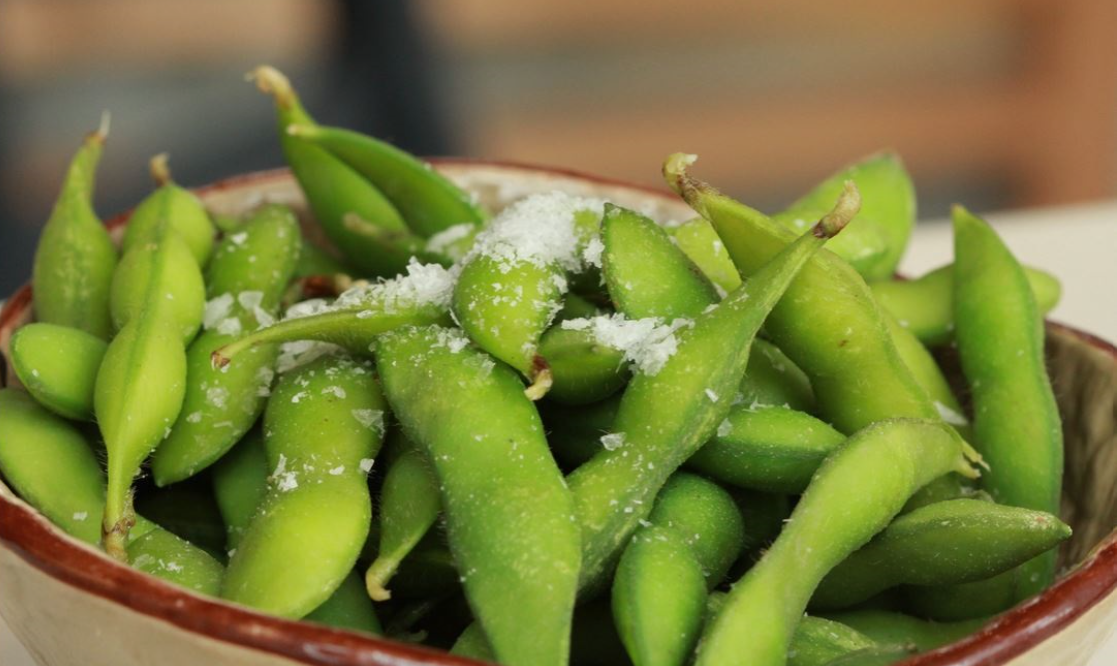
Introduction: In the bustling world of culinary delights, sometimes the simplest recipes offer the most satisfying experiences. Enter edamame with sea salt—a wholesome snack that not only tantalizes the taste buds but also packs a nutritious punch. Edamame, young soybeans still in their pods, are not only delicious but also rich in protein, fiber, and essential nutrients. When paired with the subtle yet enhancing flavor of sea salt, they become a snack that’s both wholesome and indulgent. Here’s how to whip up this delightful treat in no time.
Ingredients:
- 1 pound (about 450g) fresh or frozen edamame in their pods
- 2-3 tablespoons sea salt (adjust to taste)
- Water for boiling
Instructions:
- Prepare the Edamame: If using frozen edamame, thaw them by running them under cold water or leaving them in the refrigerator overnight. If you have fresh edamame, rinse them thoroughly under cold water.
- Boil Water: Fill a large pot with water and bring it to a rolling boil over high heat.
- Boil the Edamame: Once the water is boiling, add the edamame pods. Let them cook for about 3-5 minutes, or until they are tender. If you’re unsure, you can test one by removing it from the water, allowing it to cool slightly, and then popping a bean out of the pod to taste.
- Drain and Cool: Once the edamame are cooked to your desired tenderness, drain them in a colander and rinse them briefly under cold water. This helps to stop the cooking process and cool them down for easier handling.
- Season with Sea Salt: Transfer the cooked edamame to a serving bowl. Sprinkle them generously with sea salt, tossing gently to ensure the salt is evenly distributed.
- Serve and Enjoy: Your edamame with sea salt are now ready to be enjoyed! Serve them as a snack, appetizer, or side dish. To eat, simply squeeze the pods to release the beans into your mouth, discarding the empty pods.
- Optional Variations: Get creative with your seasoning! Experiment with adding other flavors such as garlic powder, chili flakes, or sesame seeds for an extra burst of flavor.
Serving Tips:
Garnish with Fresh Herbs: Before serving, garnish your edamame with freshly chopped herbs like cilantro, parsley, or chives. Not only will this add a pop of color, but it will also impart a fresh, aromatic flavor to the dish.
Pair with Dipping Sauces: Elevate your edamame experience by serving them with a variety of dipping sauces. Soy sauce mixed with a splash of rice vinegar and a sprinkle of sesame seeds makes for a classic and flavorful dipping option. You can also try spicy mayo, sriracha aioli, or a tangy citrus vinaigrette for a unique twist.
Serve Warm or Chilled: While edamame with sea salt is traditionally served warm, they can also be enjoyed chilled, especially on hot summer days. Simply cook them as instructed, then chill them in the refrigerator for a refreshing snack or appetizer.
Include in Bento Boxes: Pack cooked edamame with sea salt in individual compartments of a bento box for a convenient and nutritious on-the-go snack. Pair them with sushi, rice balls, fresh veggies, and fruit for a well-rounded meal that’s perfect for lunch or picnics.
Use as a Salad Topping: Sprinkle cooked edamame with sea salt on top of salads to add a protein-packed crunch. They pair especially well with leafy greens, avocado, cucumber, and sesame ginger dressing for a delicious and satisfying salad.
Storage Tips:
Refrigerate in an Airtight Container: Store any leftover cooked edamame in an airtight container and refrigerate them promptly. Properly stored, they will stay fresh for up to 3-4 days.
Keep in the Freezer: If you have a large batch of cooked edamame that you won’t be able to finish within a few days, consider freezing them for later use. Transfer the cooled edamame to a freezer-safe bag or container, removing as much air as possible before sealing. Frozen edamame will maintain their quality for up to 6 months.
Label and Date: To keep track of storage times, label the container or bag with the date when the edamame was cooked or frozen. This will help you use them before they lose their freshness.
Reheat with Care: When reheating refrigerated or frozen edamame, do so gently to prevent overcooking. Steam them briefly until heated through, or microwave them in short intervals, stirring occasionally, until warmed to your liking.
Use in Recipes: If you find yourself with an abundance of leftover edamame, consider incorporating them into other recipes. They can be added to stir-fries, soups, salads, and grain bowls for an extra boost of flavor and nutrition.
Variations to elevate your edamame with sea salt:
- Spicy Garlic Edamame:
- After boiling and draining the edamame, heat a tablespoon of olive oil or sesame oil in a skillet over medium heat.
- Add minced garlic and red pepper flakes to the skillet and sauté until fragrant, about 1-2 minutes.
- Add the cooked edamame to the skillet and toss to coat in the garlic-infused oil.
- Sprinkle with sea salt and a squeeze of fresh lemon juice before serving.
- Sesame Ginger Edamame:
- Prepare a simple sesame ginger sauce by mixing together soy sauce, sesame oil, grated ginger, and a touch of honey or maple syrup.
- Toss the cooked edamame in the sesame ginger sauce until evenly coated.
- Garnish with toasted sesame seeds and thinly sliced green onions before serving.
- Wasabi Soy Edamame:
- In a small bowl, mix together soy sauce and wasabi paste to create a spicy dipping sauce.
- Serve the cooked edamame with the wasabi soy dipping sauce on the side.
- Sprinkle the edamame with sea salt just before dipping for an extra burst of flavor.
- Truffle Parmesan Edamame:
- Drizzle the cooked edamame with truffle oil and toss to coat evenly.
- Sprinkle grated Parmesan cheese over the edamame and toss again to combine.
- Season with sea salt and freshly ground black pepper before serving.
- Thai Curry Edamame:
- Prepare a Thai curry sauce by combining coconut milk, red curry paste, a splash of fish sauce, and a squeeze of lime juice in a saucepan.
- Simmer the sauce over medium heat until it thickens slightly, then toss the cooked edamame in the sauce until well coated.
- Garnish with chopped fresh cilantro and a wedge of lime before serving.
These variations offer a range of flavors and textures to suit any palate, from spicy and savory to creamy and indulgent. Experiment with different seasonings and ingredients to create your own signature twist on classic edamame with sea salt.
Frequently Asked Questions (FAQs) about edamame with sea salt along with their answers:
- Are edamame with sea salt healthy?
- Yes, edamame with sea salt are a nutritious snack option. Edamame are rich in protein, fiber, vitamins, and minerals, while sea salt adds flavor without contributing any additional calories.
- Can I eat the edamame pods?
- While the edamame pods are edible, most people prefer to squeeze the beans out of the pods and discard the outer shell before eating. However, some enjoy chewing on the pods for added fiber.
- Can I use other types of salt instead of sea salt?
- Yes, you can use other types of salt such as kosher salt or Himalayan pink salt if you prefer. However, sea salt is often preferred for its clean, briny flavor that complements the natural sweetness of the edamame.
- Can I make edamame with sea salt ahead of time?
- Yes, you can cook the edamame ahead of time and store them in the refrigerator for up to 3-4 days. Simply season them with sea salt before serving. Alternatively, you can freeze cooked edamame for up to 6 months and reheat them when ready to eat.
- Are edamame with sea salt suitable for people with dietary restrictions?
- Edamame with sea salt are a vegan, gluten-free, and nut-free snack option, making them suitable for a wide range of dietary preferences. However, individuals with soy allergies should avoid edamame.
- Can I customize the seasoning for edamame with sea salt?
- Yes, you can customize the seasoning to suit your taste preferences. Experiment with different spices, herbs, and seasonings such as garlic powder, chili flakes, sesame seeds, or flavored salts for a unique twist.
- How do I know when the edamame are cooked?
- Edamame are typically cooked when they are tender but still slightly firm. You can test for doneness by removing a bean from the pod and tasting it. If it’s soft and easy to chew, the edamame are ready.
- Are there any potential allergens in edamame with sea salt?
- While edamame with sea salt are generally allergen-friendly, it’s important to note that soy is a common allergen. Individuals with soy allergies should avoid consuming edamame.
In conclusion, edamame with sea salt offers a delightful combination of simplicity, flavor, and nutrition. This humble yet versatile snack is not only easy to prepare but also packs a punch in terms of health benefits. Whether enjoyed as a wholesome appetizer, a nutritious snack, or a flavorful side dish, edamame with sea salt never fails to satisfy.
With its rich protein content, fiber, vitamins, and minerals, edamame provides a nourishing boost to any diet. Meanwhile, the addition of sea salt enhances the natural sweetness of the beans, creating a perfect balance of flavors.
